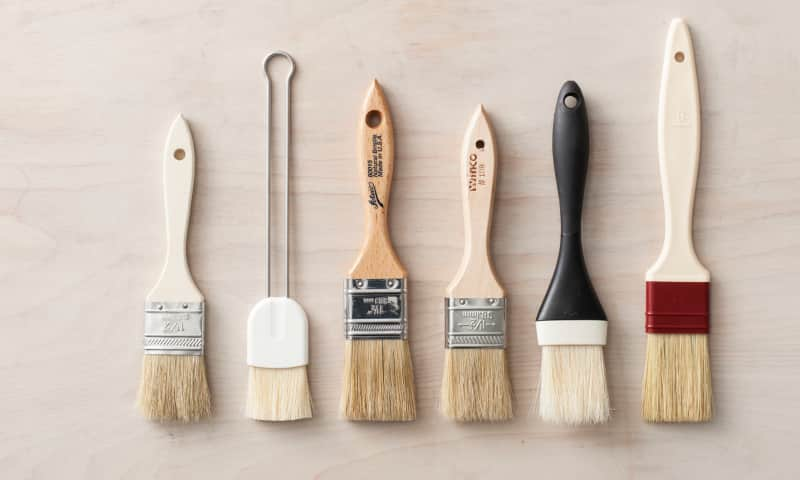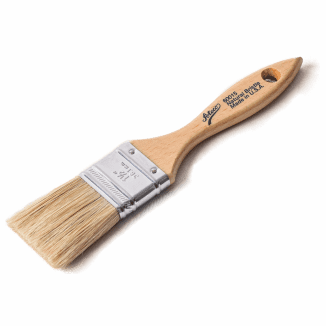We love our favorite silicone brush for basting meat and poultry and for oiling hot pans. But for spreading egg wash, glaze, or melted butter on delicate doughs or pastry and for removing crumbs from layer cakes before frosting them, we prefer to use a pastry brush with natural-fiber bristles. Because these bristles are so fine, they allow you to apply liquids more precisely and with a gentler touch than silicone models, which generally have thicker, spaghetti-size bristles. Moreover, natural-fiber brushes simply have more bristles, so they can wick up more liquid.
We wanted to know which natural-fiber pastry brush was the best, so we bought six models and pitted them against our reigning silicone model, the OXO Good Grips Silicone Pastry Brush. All the brushes had 1.5-inch-wide heads (the most commonly available size); five were made with boar’s-hair bristles and one with silk bristles. We put them to the test, using them to apply viscous egg wash to raw bread dough, slick olive oil to sheets of phyllo, and thick, sticky glazes to fruit tarts.

Bristles Determine Minor Performance Differences
The good news is that all the brushes did a respectable job with every task. Compared with our favorite silicone model, the natural-fiber brushes picked up two to four times more liquid and dispensed it much more evenly, gently, and precisely.
However, there were some minor differences in performance that were determined by the length, uniformity, and density of the bristles; the material itself didn’t seem to be significant. Bristles that were just under 2 inches in length provided the right combination of agility and coverage. Longer bristles were great for reaching into the nooks and crannies of the fruit tarts but were a touch unwieldy when applying oil to phyllo. Shorter bristles felt stubby and had less surface area with which to cover the food; they lacked the supple swish and fluidity of longer bristles.
Most testers also preferred brushes with bristles that were uniformly the same length throughout the head; bristles of different lengths tended to stick out like flyaways, making for slightly less precise, controlled application.
Additionally, we liked brush heads that were moderately dense, about ½ inch or more in thickness. The thicker the brush head, the more bristles it generally had and thus the more liquid it could retain, letting us reload the brush a little less often. Still, these differences in capacity weren’t all that dramatic—at most, it meant that a brush took three passes to cover a 14 by 9-inch sheet of phyllo instead of two.
And while we wanted a thick head with lots of bristles, it was important that the bristles not be too tightly bunched inside the head. Brushes with densely packed bristles felt stiff and were a little rougher on the food, pushing over and bruising some of the berries on the fruit tart and more readily tearing the phyllo dough.

Handles Matter
Handle shape and material mattered as well. We liked handles that were comfortable to hold for extended sessions, preferring those that were relatively thick (2 to 2.5 inches in circumference) and made from materials that were easy to grip even when wet or greasy; rubbery plastic was ideal, but varnished wood was just fine, too. Bare metal was too slippery, and unfinished wood made testers worry about splinters. Handles of medium length (4.75 to 5 inches) were easy for testers of all hand sizes to wield precisely; longer handles took us a little too far from the action and generally made for clumsier maneuvering.

A Durability Problem
Finally, a note about durability. Natural-fiber pastry brushes are somewhat notorious for shedding bristles when you use and wash them. The brushes in our lineup were no exception: They each dropped at least a couple of bristles over the course of testing, and the worst lost more than a dozen, not including any that may have been shed during dish washing.

Our winner, the Winco Flat Pastry and Basting Brush, 1½ inch, was the most durable of the bunch, losing just two bristles during testing and handwashing. Those bristles were uniformly the ideal length for most testers (1.8 inches) and there were plenty of them, packed neither too tightly nor too loosely into the brush head, which was the thickest in our lineup. As a result, the brush picked up some of the greatest volumes of liquid, but it still felt flexible, maneuverable, and precise. Finally, its thick, varnished wood handle was easy for testers of all hand sizes to hold.
The Tests
- Apply egg wash to raw bread dough
- Apply glaze to fruit tart
- Apply olive oil to sheets of phyllo dough
- Wash each brush by hand 10 times
- Record bristles lost throughout testing
- Have users of different hand sizes, dominant hands, and levels of pastry experience test-drive
How We Rated
- Performance: We evaluated each brush on how much liquid it held and how agile, precise, and gentle it was in action.
- Comfort: We rated each brush on how grippy and comfortable it was to hold.
- Durability: We evaluated each brush on how durable it was, counting the number of bristles it lost over the course of testing.
- Bristles that are uniformly 1.8 to 1.9 inches long
- Moderately dense bristle head that measures about ½ inch thick
- Grippy handle 4.75 to 5 inches long and 2 to 2.5 inches in circumference
- Loses relatively few bristles during use and handwashing














